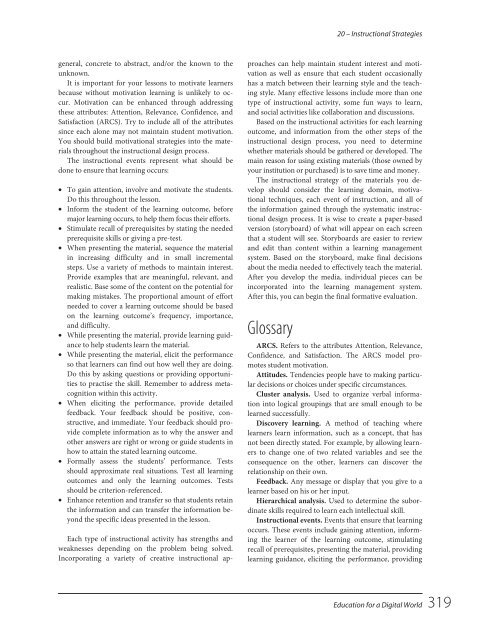Education for a Digital World Advice, Guidelines and Effective Practice from Around Globe, 2008a
Education for a Digital World Advice, Guidelines and Effective Practice from Around Globe, 2008a
Education for a Digital World Advice, Guidelines and Effective Practice from Around Globe, 2008a
Create successful ePaper yourself
Turn your PDF publications into a flip-book with our unique Google optimized e-Paper software.
20 – Instructional Strategies<br />
general, concrete to abstract, <strong>and</strong>/or the known to the<br />
unknown.<br />
It is important <strong>for</strong> your lessons to motivate learners<br />
because without motivation learning is unlikely to occur.<br />
Motivation can be enhanced through addressing<br />
these attributes: Attention, Relevance, Confidence, <strong>and</strong><br />
Satisfaction (ARCS). Try to include all of the attributes<br />
since each alone may not maintain student motivation.<br />
You should build motivational strategies into the materials<br />
throughout the instructional design process.<br />
The instructional events represent what should be<br />
done to ensure that learning occurs:<br />
• To gain attention, involve <strong>and</strong> motivate the students.<br />
Do this throughout the lesson.<br />
• In<strong>for</strong>m the student of the learning outcome, be<strong>for</strong>e<br />
major learning occurs, to help them focus their ef<strong>for</strong>ts.<br />
• Stimulate recall of prerequisites by stating the needed<br />
prerequisite skills or giving a pre-test.<br />
• When presenting the material, sequence the material<br />
in increasing difficulty <strong>and</strong> in small incremental<br />
steps. Use a variety of methods to maintain interest.<br />
Provide examples that are meaningful, relevant, <strong>and</strong><br />
realistic. Base some of the content on the potential <strong>for</strong><br />
making mistakes. The proportional amount of ef<strong>for</strong>t<br />
needed to cover a learning outcome should be based<br />
on the learning outcome’s frequency, importance,<br />
<strong>and</strong> difficulty.<br />
• While presenting the material, provide learning guidance<br />
to help students learn the material.<br />
• While presenting the material, elicit the per<strong>for</strong>mance<br />
so that learners can find out how well they are doing.<br />
Do this by asking questions or providing opportunities<br />
to practise the skill. Remember to address metacognition<br />
within this activity.<br />
• When eliciting the per<strong>for</strong>mance, provide detailed<br />
feedback. Your feedback should be positive, constructive,<br />
<strong>and</strong> immediate. Your feedback should provide<br />
complete in<strong>for</strong>mation as to why the answer <strong>and</strong><br />
other answers are right or wrong or guide students in<br />
how to attain the stated learning outcome.<br />
• Formally assess the students’ per<strong>for</strong>mance. Tests<br />
should approximate real situations. Test all learning<br />
outcomes <strong>and</strong> only the learning outcomes. Tests<br />
should be criterion-referenced.<br />
• Enhance retention <strong>and</strong> transfer so that students retain<br />
the in<strong>for</strong>mation <strong>and</strong> can transfer the in<strong>for</strong>mation beyond<br />
the specific ideas presented in the lesson.<br />
Each type of instructional activity has strengths <strong>and</strong><br />
weaknesses depending on the problem being solved.<br />
Incorporating a variety of creative instructional approaches<br />
can help maintain student interest <strong>and</strong> motivation<br />
as well as ensure that each student occasionally<br />
has a match between their learning style <strong>and</strong> the teaching<br />
style. Many effective lessons include more than one<br />
type of instructional activity, some fun ways to learn,<br />
<strong>and</strong> social activities like collaboration <strong>and</strong> discussions.<br />
Based on the instructional activities <strong>for</strong> each learning<br />
outcome, <strong>and</strong> in<strong>for</strong>mation <strong>from</strong> the other steps of the<br />
instructional design process, you need to determine<br />
whether materials should be gathered or developed. The<br />
main reason <strong>for</strong> using existing materials (those owned by<br />
your institution or purchased) is to save time <strong>and</strong> money.<br />
The instructional strategy of the materials you develop<br />
should consider the learning domain, motivational<br />
techniques, each event of instruction, <strong>and</strong> all of<br />
the in<strong>for</strong>mation gained through the systematic instructional<br />
design process. It is wise to create a paper-based<br />
version (storyboard) of what will appear on each screen<br />
that a student will see. Storyboards are easier to review<br />
<strong>and</strong> edit than content within a learning management<br />
system. Based on the storyboard, make final decisions<br />
about the media needed to effectively teach the material.<br />
After you develop the media, individual pieces can be<br />
incorporated into the learning management system.<br />
After this, you can begin the final <strong>for</strong>mative evaluation.<br />
Glossary<br />
ARCS. Refers to the attributes Attention, Relevance,<br />
Confidence, <strong>and</strong> Satisfaction. The ARCS model promotes<br />
student motivation.<br />
Attitudes. Tendencies people have to making particular<br />
decisions or choices under specific circumstances.<br />
Cluster analysis. Used to organize verbal in<strong>for</strong>mation<br />
into logical groupings that are small enough to be<br />
learned successfully.<br />
Discovery learning. A method of teaching where<br />
learners learn in<strong>for</strong>mation, such as a concept, that has<br />
not been directly stated. For example, by allowing learners<br />
to change one of two related variables <strong>and</strong> see the<br />
consequence on the other, learners can discover the<br />
relationship on their own.<br />
Feedback. Any message or display that you give to a<br />
learner based on his or her input.<br />
Hierarchical analysis. Used to determine the subordinate<br />
skills required to learn each intellectual skill.<br />
Instructional events. Events that ensure that learning<br />
occurs. These events include gaining attention, in<strong>for</strong>ming<br />
the learner of the learning outcome, stimulating<br />
recall of prerequisites, presenting the material, providing<br />
learning guidance, eliciting the per<strong>for</strong>mance, providing<br />
<strong>Education</strong> <strong>for</strong> a <strong>Digital</strong> <strong>World</strong> 319


















